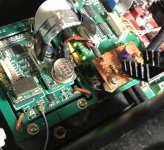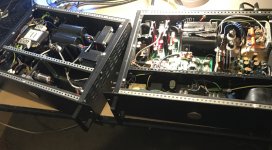A Digital to Analog Converter is like an orchestra that plays music following the exact time stated by the Director, the Clock.
Each hesitation of the Director makes the orchestra less clean, more cloudy. At the same way a jittered clock makes even the best DAC sound more blurred loosing the details that makes music alive.
Due to its exceptionally low phase noise and a consequent negligible jitter the Pulsar Clock pushes at the top the performance of any DAC, to test this performance and compare different clocks we made two different setup for synchronous and asynchronous DAC convertion.
Great care was taken to minimize the hardware induced jitter compatibly with the need to realize a very flexible and easily reconfigurable structure to allocate different clocks and different frequencies.
Synchronous Configuration is described by the block diagram in picture S1, the whole hardware is shown in picture S2:
- Player: Volumio 1.4 from Michelangelo Guarise on Raspberry PI with I2S output, a bitperfect player up to 24/192. Picture S3 shows I2S connections from the Raspberry PI
- FIFO buffer from iancanada to synchronize the I2S data flow
- Isolator from iancanada to ehnance data accuracy providing galvanic isolation
- Pulsar Clock pair on Dual-XO board from iancanada, the location where the ultralow jitter reclock is made. Current DualXO version is able to power the Pulsar Clock pair both during the short warm-up and the operational phases. In our configuration we use a 5Vdc battery to supply the DualXO board with minimum noise. Picture S4 shows the "FIFO - Isolator - DualXO" de-jitter block
- ES9018 Buffalo III from Twisted Pear Audio powered by Pulsar Power boards on 3.3V Analog and Digital lines, the board was modified to accept an external clock on the dedicated three pins with the iancanada adapter. Pictures S5 and S6 show the most critical digital path, the connection between the DualXO and Buffalo III boards, this connection could be slightly improved in a fixed implementation but performs very well also in this flexible configuration
- NTD1 I-V Converter Version 3 from Owen, a stunning Class A converter with a state of the art linearity expressly designed to accomodate the Buffalo III board for maximum quality of the analog signal
Asynchronous Configuration is described by the block diagram in picture A1:
- Player: Volumio 1.4 from Michelangelo Guarise on Raspberry PI with I2S output, a bitperfect player up to 24/192
- ES9018 Buffalo III from Twisted Pear Audio powered by Pulsar Power boards on 3.3V Analog, Digital and Clock lines, the board was modified to accept an external clock on the dedicated three pins with the iancanada adapter. Picture A2 shows the Pulsar Clock on the iancanada clock adapter
- NTD1 I-V Converter Version 3 from Owen, a stunning Class A converter with a state of the art linearity expressly designed to accomodate the Buffalo III board for maximum quality of the analog signal
Hi, I re-read this post and found that the comparison was not so fair. The syn mode also benefit from noise isolation and reclocking. Have you tried asyn mode with isolation and reclocking, and how was this option compared to syn with isolation and reclocking?
Thanks.
Wyan,
the post you quoted was just the description of the implementation of a Synchronous and an Asynchronous configuration with the ES9018 DAC and there is no comparison between the two configurations.
Let's anyway distinguish between "reclocking" and "isolation" effects.
Reclocking if performed both in the synchronous and in the asyncronous configurations, in the synchronous configuration it is performed inside Ian's reclocker unit sharing the same clock of the ES9018 (i.e. they are synchronous) while in the asychronous configuration the reclocking is performed inside the ES9018 by means of it's internal DPLL and the data clock is "not" the clock of the ES9018 (i.e. they are asynchronous).
Reclocking is implicitly always assumed to be the above mentioned "external" reclocking to the same DAC Master Clock so it is incompatible with the asynchronous concept.
Isolation is a very important step in the data flow, it keeps galvanically separated two stages preventing the noise of the upstream stage to influence in a bad way the downstream stage but we have to consider both the positive and the negative effects.
Positive effect: the noise associated to the source could change in a less or more significant way the switching time of the logic circuits and this means "increase the jitter" so isolation reduces the jitter induced by the noise.
Negative effect: the electronics of the isolators introduces a jitter due to the nature of their circuits.
In conclusion:
In a Synchronous configuration the isolator keeps apart the noise of the source, the FIFO togheter with the Reclocker regenerates the signal removing any previous jitter and the ES9018 DPLL works at its absolutely best performance because the input signal is synchronous to the same Master Clock.
In an Asynchronous configuration the ES9018 have to do all the dirthy job and clearly it works better if the incoming signal is a less jittered signal. If the source is a good source with low jitter and low noise and an isolator is introduced the negative effect could prevail on the positive effect degrading the system quality. If the source is a noisy and heavily jittered source the positive effects should prevail giving a better system quality.
From the above considerations is clear that a "comparison" between synchronous and asynchronous configurations risks to be meaningless because a correct implementation of a synchronous configuration removes all the unpredictable effects of noise and jitter on an asyncronous configuration. Clearly an asynchronous configuration is cheaper.
the post you quoted was just the description of the implementation of a Synchronous and an Asynchronous configuration with the ES9018 DAC and there is no comparison between the two configurations.
Let's anyway distinguish between "reclocking" and "isolation" effects.
Reclocking if performed both in the synchronous and in the asyncronous configurations, in the synchronous configuration it is performed inside Ian's reclocker unit sharing the same clock of the ES9018 (i.e. they are synchronous) while in the asychronous configuration the reclocking is performed inside the ES9018 by means of it's internal DPLL and the data clock is "not" the clock of the ES9018 (i.e. they are asynchronous).
Reclocking is implicitly always assumed to be the above mentioned "external" reclocking to the same DAC Master Clock so it is incompatible with the asynchronous concept.
Isolation is a very important step in the data flow, it keeps galvanically separated two stages preventing the noise of the upstream stage to influence in a bad way the downstream stage but we have to consider both the positive and the negative effects.
Positive effect: the noise associated to the source could change in a less or more significant way the switching time of the logic circuits and this means "increase the jitter" so isolation reduces the jitter induced by the noise.
Negative effect: the electronics of the isolators introduces a jitter due to the nature of their circuits.
In conclusion:
In a Synchronous configuration the isolator keeps apart the noise of the source, the FIFO togheter with the Reclocker regenerates the signal removing any previous jitter and the ES9018 DPLL works at its absolutely best performance because the input signal is synchronous to the same Master Clock.
In an Asynchronous configuration the ES9018 have to do all the dirthy job and clearly it works better if the incoming signal is a less jittered signal. If the source is a good source with low jitter and low noise and an isolator is introduced the negative effect could prevail on the positive effect degrading the system quality. If the source is a noisy and heavily jittered source the positive effects should prevail giving a better system quality.
From the above considerations is clear that a "comparison" between synchronous and asynchronous configurations risks to be meaningless because a correct implementation of a synchronous configuration removes all the unpredictable effects of noise and jitter on an asyncronous configuration. Clearly an asynchronous configuration is cheaper.
Another Pulsar Clock making music!
I have replaced 22.xxxMHz Crystek with same value Pulsar Clock, also modified Ians Dual Clock board to bypass his on board LDOs and utilised Pulsars ADM7150 Power Board.
What to say.. all you read here is true. I was expecting a difference, but the magnitude of difference is so immediately obvious and not at all subtle.
Not cheap, but all considered.. probably the best money I've spent in audio for quite some time. Like they say, once heard, you cannot un-hear it.
Cheers to Pulsar for the new year, and a special thanks to them for making this product available.
I have replaced 22.xxxMHz Crystek with same value Pulsar Clock, also modified Ians Dual Clock board to bypass his on board LDOs and utilised Pulsars ADM7150 Power Board.
What to say.. all you read here is true. I was expecting a difference, but the magnitude of difference is so immediately obvious and not at all subtle.
Not cheap, but all considered.. probably the best money I've spent in audio for quite some time. Like they say, once heard, you cannot un-hear it.
Cheers to Pulsar for the new year, and a special thanks to them for making this product available.
Attachments
PULSAR CLOCK FALL SALE
Glad to announce that the Pulsar Clock Fall Sale Shop is now open on www.pulsarclock.com
130.00 Euro OFF on Pulsar Clock
10.50 Euro OFF on Pulsar Power
Now available in the Pulsar Clock Shop
An externally hosted image should be here but it was not working when we last tested it.
Glad to announce that the Pulsar Clock Fall Sale Shop is now open on www.pulsarclock.com
130.00 Euro OFF on Pulsar Clock
10.50 Euro OFF on Pulsar Power
Now available in the Pulsar Clock Shop
Pulsar Clock Shop Closing Down Soon!
Don't loose the chance to improve your system performance to the highest, only few parts still available!
Everything must go Sale
Grab your Pulsar Clock & Pulsar Power now before it's too late!
Shop closes down on December the 9th
An externally hosted image should be here but it was not working when we last tested it.
Don't loose the chance to improve your system performance to the highest, only few parts still available!
Everything must go Sale
Grab your Pulsar Clock & Pulsar Power now before it's too late!
Shop closes down on December the 9th
LAST PULSAR CLOCK SHOPPING DAY !!!
DON'T LOOSE THE VERY LAST OPPORTUNITY!
THIS IS THE LAST SHOPPING DAY!
DON'T LOOSE THE VERY LAST OPPORTUNITY!
THIS IS THE LAST SHOPPING DAY!
An externally hosted image should be here but it was not working when we last tested it.
An externally hosted image should be here but it was not working when we last tested it.
Season's Greetings and a Happy New Year!
Hi,
I am so sad that we no longer can buy this fantastic quality of Pulsar OCXOs.
I need further Pulsar OCXOs or comparable quality for my next projects.
I am looking for OCXO Kits with 22.579 / 24.576 MHz and 45.158 /49.152 MHz
Can anyone help me ?
Thanks in advance!
Horst
I am so sad that we no longer can buy this fantastic quality of Pulsar OCXOs.
I need further Pulsar OCXOs or comparable quality for my next projects.
I am looking for OCXO Kits with 22.579 / 24.576 MHz and 45.158 /49.152 MHz
Can anyone help me ?
Thanks in advance!
Horst
Last edited:
Much more expensive NDK DuCULoN
https://www.ndk.com/en/news/2015/1190895_e.pdf
or an alternative the clock of Andrea
The Well Tempered Master Clock - Group buy
https://www.ndk.com/en/news/2015/1190895_e.pdf
or an alternative the clock of Andrea
The Well Tempered Master Clock - Group buy
- Home
- Vendor's Bazaar
- Pulsar Clock - Ultra Low Noise OCXO


